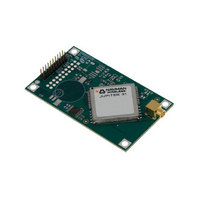AA003041-G Navman Wireless, AA003041-G Datasheet - Page 7

AA003041-G
Manufacturer Part Number
AA003041-G
Description
MODULE JUPITER 31 GPS W/R/A OSX
Manufacturer
Navman Wireless
Specifications of AA003041-G
Frequency
1.575GHz
Sensitivity
-159dBm
Modulation Or Protocol
GPS
Applications
GPS
Data Interface
Connector, 2 x 10 Header, 2 mm Pitch
Antenna Connector
OSX
Voltage - Supply
3.3V
Operating Temperature
-40°C ~ 85°C
Package / Case
Module
Lead Free Status / RoHS Status
Lead free / RoHS Compliant
Features
-
Memory Size
-
Data Rate - Maximum
-
Current - Receiving
-
Other names
943-1007
2.7 Marking/Serialisation
The Jupiter 31 supports a 128 barcode indicating the unit serial number. The Navman
13-character serial number convention is:
3.0 Performance characteristics
All parameters specified in this section are based on room temperature conditions (22 ± 2°C) and
a typical power supply voltage (3.3 ± 0.1 V or
3.1 TTFF (Time To First Fix)
TTFF is the actual time required by a GPS receiver to achieve a position solution. This
specification will vary with the operating state of the receiver, the length of time since the last
position fix, the location of the last fix, and the specific antenna design. Use of battery backup is
recommended for proper operation.
3.2 Acquisition times
Table 3-1 shows the corresponding TTFF times for each of the acquisition modes.
3.3 Timing 1 PPS output
The 1 PPS output of the Jupiter 31 receiver is < 1 µs, typical ± 300 ns ref UTC. Refer to Table 6-2
for the default status on the Jupiter 31.
3.4 Power management
The Jupiter 31 offers two power saving modes: Adaptive TricklePower and Push-To-Fix, which
can be set using NMEA or SiRF Binary messages.
LA010811B © 2008 Navman Wireless OEM Solutions. All rights reserved. Proprietary information and specifications subject to change without notice.
3.1.1 Hot start
A hot start results from a software reset after a period of continuous navigation, or a return
from a short idle period (i.e. a few minutes) that was preceded by a period of continuous
navigation. In this state, all of the critical data (position, velocity, time, and satellite
ephemeris) is valid to the specified accuracy and available in SRAM. Battery backup of the
SRAM and RTC during loss of power is required to achieve a hot start.
3.1.2 Warm start
A warm start typically results from user-supplied position and time initialization data or
continuous RTC operation with an accurate last known position available in memory. In this
state, position and time data are present and valid but ephemeris data validity has expired.
3.1.3 Cold start
A cold start acquisition results when either position or time data is unknown. Almanac
information is used to identify previously healthy satellites.
characters 1 and 2: year of manufacture (e.g. 06 = 2006, 07 = 2007)
characters 3 and 4: week of manufacture (1 to 52, starting first week in January)
character 5: manufacturer code
characters 6 and 7: product and type
character 8: product revision
characters 9-13: sequential serial number
Re-acquisition (<10 s obstruction)
Warm start TTFF
Cold start TTFF
Hot start TTFF
Table 3-1: Acquisition times
Mode
5.0 ± 0.1
V) unless otherwise stated.
0.5 s
31 s
33 s
@ -125 dBm
Typ
1 s
90%
< 1 s
36 s
38 s























